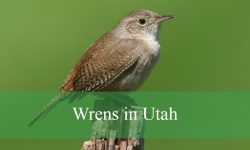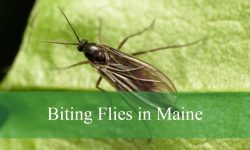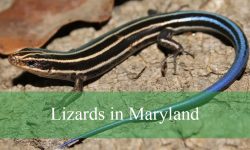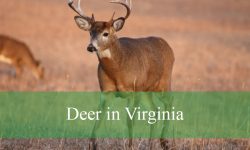Owls in Colorado are as diverse as the landscapes they inhabit, ranging from the open plains to the dense coniferous forests of the Rockies. These fascinating birds of prey can be found across the state, each species adapted to a unique environment. With their haunting calls, keen eyesight, and silent flight, owls play a vital role in Colorado’s ecosystems, helping to control rodent populations and maintain ecological balance.
From the large and powerful Great Horned Owl to the tiny but fearless Northern Pygmy-Owl, Colorado is home to at least eleven distinct owl species. Some, like the Burrowing Owl, are active during the day and live underground, while others, such as the Flammulated Owl, are secretive and migratory, appearing only in the summer months. Whether you live in the mountains, on the plains, or in the suburbs, chances are you may share your surroundings with one of these remarkable birds.
This guide will introduce you to 11 types of owls in Colorado, complete with pictures and identification tips. You’ll learn how to recognize each species by their appearance, calls, size, and behavior, as well as where and when you’re most likely to spot them.
Common Owls Found in Colorado
Great Horned Owl (Bubo virginianus)
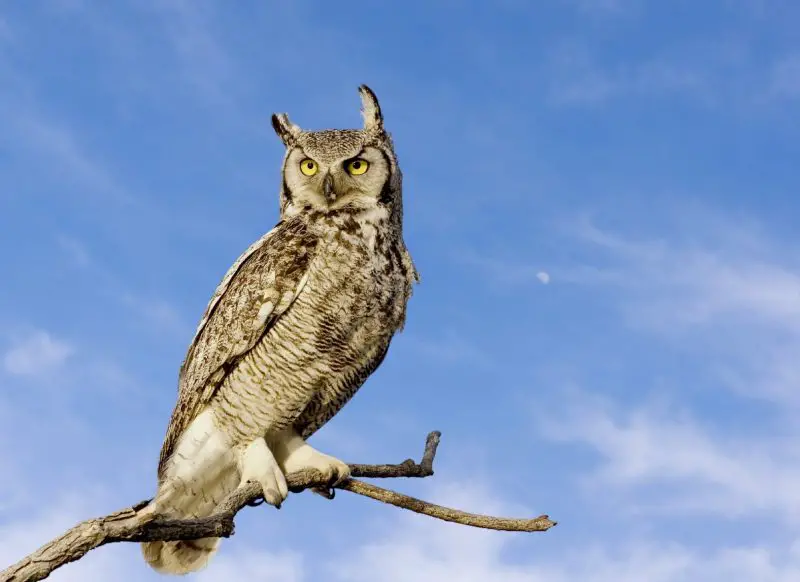
The Great Horned Owl is one of Colorado’s most iconic and adaptable raptors, known for its impressive size and fierce demeanor. Adults typically measure between 18 to 25 inches in length with a wingspan ranging from 3.3 to 4.8 feet. Their most striking features are the prominent feather tufts on their heads, which resemble horns, and their large, yellow eyes that stand out against their mottled brown, gray, and white plumage. This species has a deep, resonant hooting call that echoes through its territory, particularly at dawn and dusk.
These owls are apex nocturnal predators, capable of taking down prey much larger than themselves, including skunks, rabbits, and other birds. They hunt primarily at night using their acute hearing and silent flight to surprise prey. Their talons are extremely strong, allowing them to exert powerful crushing force. Despite their size, they are stealthy hunters, making them feared by many smaller animals and even other birds of prey.
In terms of diet, Great Horned Owls are highly opportunistic and feed on a wide variety of animals. Mammals such as mice, voles, and rabbits are common, but they also eat birds, reptiles, amphibians, and even insects when necessary. They are known to cache food in hidden spots and revisit it later. Their adaptability in hunting and eating habits has helped them thrive across a range of environments.
In Colorado, Great Horned Owls are found throughout the state, from mountain forests and desert canyons to farmlands and city parks. They are year-round residents and often nest early in the year—sometimes even in January—using abandoned nests from other large birds or cliff ledges. Their broad ecological tolerance makes them one of the most frequently seen and heard owls across the region.
Western Screech-Owl (Megascops kennicottii)
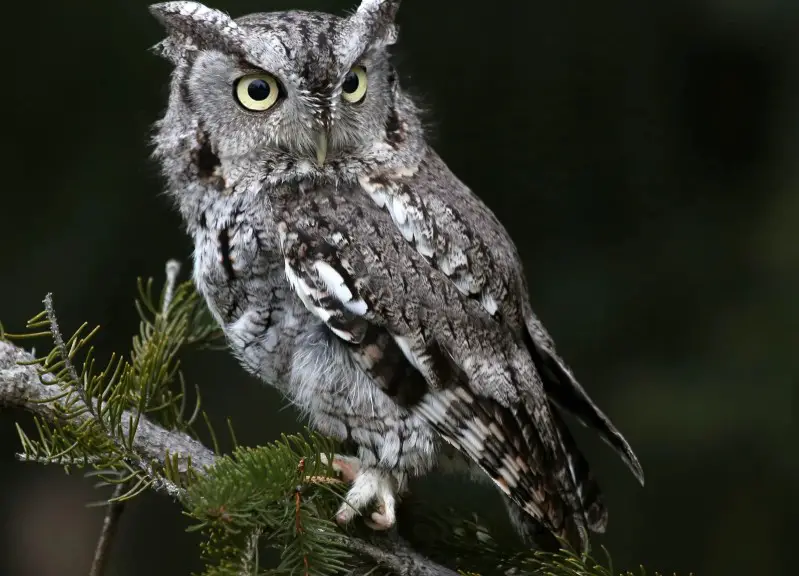
The Western Screech-Owl is a small, compact owl with a length of about 7 to 10 inches and a wingspan around 20 inches. Despite their name, they do not screech but rather emit a series of soft, melodic whistles or trills. Their plumage is well-camouflaged in mottled shades of gray or reddish-brown, helping them blend into tree bark. Distinctive ear tufts and bright yellow eyes give them a slightly fierce yet endearing look.
These owls are mostly nocturnal and become active around dusk. They are generally solitary and elusive, spending daylight hours in tree cavities or nestled against trunks. They have a calm demeanor but are highly effective predators for their size. Their compact frame and excellent hearing enable them to swoop down silently on unsuspecting prey.
Western Screech-Owls primarily feed on small mammals such as mice and voles, but they also consume insects, small birds, lizards, and amphibians. Their diet changes with the seasons, with more insects eaten in warmer months and more mammals in colder ones. They often hunt from low perches, waiting patiently before striking quickly and efficiently.
In Colorado, the Western Screech-Owl is more commonly found in the western and southern parts of the state. It inhabits riparian woodlands, desert canyons, and even residential neighborhoods with mature trees. This species is a cavity nester, using old woodpecker holes or nest boxes to raise their young. Their adaptability to both wild and semi-urban areas makes them a relatively common yet seldom-seen presence in suitable habitats.
Eastern Screech-Owl (Megascops asio)

The Eastern Screech-Owl closely resembles its western counterpart in size and appearance, measuring about 6.5 to 10 inches long with a wingspan of up to 24 inches. It comes in two main color morphs: gray and reddish-brown, both providing excellent camouflage against tree bark. Like the Western Screech-Owl, it has small “ear” tufts and bright yellow eyes. Its vocalizations are varied and include a haunting trill or whinny-like call, often heard at night.
Though small, this owl is a confident and proficient nocturnal hunter. It typically hunts from a low perch and uses a swift swoop to catch prey on the ground or in low vegetation. The Eastern Screech-Owl is known for being especially tolerant of human activity and often goes unnoticed in suburban and even urban neighborhoods.
This species feeds on a broad range of small animals, including insects, rodents, small birds, frogs, and even earthworms. Their diet changes with the seasons and the availability of prey. They are opportunistic feeders and have even been observed taking fish or small snakes near water bodies. Nesting typically occurs in tree cavities or nest boxes, and they show strong site fidelity once they find a suitable location.
In Colorado, the Eastern Screech-Owl is most common in the eastern plains and along riparian woodlands near agricultural lands. It favors areas with mature deciduous trees and is often found in cottonwood groves or shelterbelts near farms. Although not as widespread across the state as the Great Horned Owl, it is a common resident in its preferred range and can be readily detected by its nighttime calls.
Barn Owl (Tyto alba)

The Barn Owl is unmistakable with its heart-shaped, pale facial disk and ghostly white or golden body. Measuring around 12 to 16 inches in length and with a wingspan of 3 to 3.5 feet, it has long legs and a graceful flight. Unlike most owls, Barn Owls lack ear tufts, and their dark eyes give them a mysterious and haunting appearance. Their flight is virtually silent, and their eerie, raspy screech adds to their reputation as spectral night hunters.
These owls are strictly nocturnal and are rarely seen during the day. They are skilled rodent hunters and can detect prey with remarkable accuracy using their exceptional hearing. The structure of their facial disk helps funnel sound toward their ears, allowing them to pinpoint movement even in complete darkness. Once located, prey is captured with swift, low glides over open ground.
Barn Owls feed almost exclusively on small mammals, particularly rodents like mice, voles, and rats. A single Barn Owl can consume dozens of rodents in a night, making them valuable natural pest controllers. They hunt over open habitats, gliding just above the ground with slow, buoyant wingbeats, and use barns, silos, old buildings, or tree cavities for roosting and nesting.
In Colorado, Barn Owls are found in open landscapes such as prairies, farmlands, and desert edges, especially in the eastern and southern parts of the state. They are often associated with human-made structures and nest in barns or other quiet, abandoned buildings. While not as common as some other owls in forested areas, they are a vital part of the ecosystem in rural and agricultural zones where rodent populations are high.
Northern Saw-whet Owl (Aegolius acadicus)
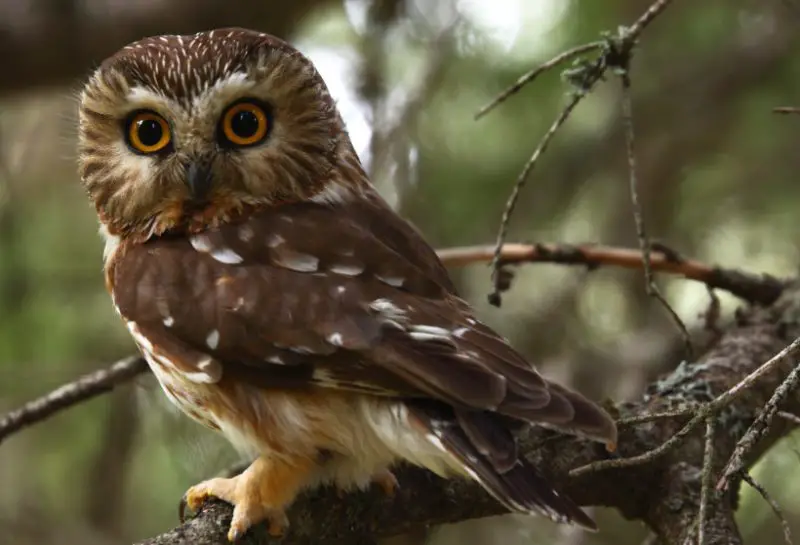
The Northern Saw-whet Owl is a small, elusive species that reaches only about 7 to 8.5 inches in length, with a wingspan around 16.5 to 19 inches. It has a compact, round body and a large head with no ear tufts. Its plumage is rich brown with white spotting on the head and back, and its large yellow eyes are surrounded by a pale facial disk that gives it an innocent, almost toy-like appearance. The name “saw-whet” refers to its repetitive tooting call, said to resemble the sound of a whetstone sharpening a saw.
This species is notoriously secretive and nocturnal, spending most of the day roosting quietly in dense vegetation. They are solitary and often go undetected even when present. Despite their small size, they are skilled hunters, using stealth and precision to capture prey in low-light conditions. They rely on excellent hearing and night vision to locate and snatch prey from the forest floor.
Northern Saw-whet Owls primarily feed on small rodents, especially deer mice, but they also eat shrews, voles, and occasionally small birds or insects. During peak hunting periods, they may store surplus food in tree branches or cavities. They typically hunt in short bursts from low perches, and their small size enables them to maneuver through dense undergrowth with ease.
In Colorado, these owls are most commonly found in high-elevation coniferous forests, particularly in the central and northern mountains. They are most detectable during fall and winter when some individuals migrate to lower elevations. Though they are year-round residents in some mountainous regions, their secretive behavior and preference for dense forest cover make sightings relatively rare. Their presence is more often detected by their persistent nighttime calls during the breeding season.
Burrowing Owl (Athene cunicularia)

The Burrowing Owl is a unique species among owls due to its diurnal habits and terrestrial lifestyle. Measuring about 7.5 to 10 inches long with a wingspan of 20 to 24 inches, it has long legs, a short tail, and a rounded head without ear tufts. Its plumage is mottled brown and white, with striking yellow eyes and a bold white eyebrow line. Its upright posture and daytime activity make it more conspicuous than most owls.
Unlike tree-dwelling species, Burrowing Owls live in underground burrows, often repurposed from prairie dogs or ground squirrels. They are most active during the day, especially during dawn and dusk. These owls often perch on fence posts or small mounds to watch for danger or hunt for prey. When threatened, they may hiss or mimic the sound of rattlesnakes to deter predators.
Burrowing Owls primarily feed on insects such as beetles, crickets, and grasshoppers, as well as small mammals like mice and voles. They may also eat small birds, reptiles, or amphibians. Their hunting strategy involves running or gliding along the ground, as well as swooping down from low perches. They are also known to cache food near their burrows for later use.
In Colorado, Burrowing Owls are found mainly in the eastern plains, particularly in open grasslands, agricultural fields, and prairie dog colonies. They arrive in spring to breed and migrate southward in fall. Because of their preference for prairie ecosystems, they are considered vulnerable to habitat loss and declining prairie dog populations, which directly affect their nesting opportunities.
Long-eared Owl (Asio otus)

The Long-eared Owl is a medium-sized owl, measuring 13 to 16 inches in length with a wingspan between 35 to 39 inches. It is most recognizable by its long, vertical ear tufts and its cryptic brown and gray streaked plumage, which blends seamlessly with tree bark. Its facial disk is framed in dark markings with bright orange eyes, giving it a piercing gaze. When threatened or resting, it elongates its body to mimic a broken branch for camouflage.
This species is nocturnal and extremely secretive during the day, often roosting silently in dense coniferous trees or shrubs. It prefers to remain still and hidden, making it difficult to spot even in known habitats. At night, it becomes an agile and efficient hunter, flying silently through the forest edge in search of food.
Long-eared Owls primarily eat small mammals, especially voles, mice, and shrews. Occasionally, they may also prey on small birds. Their hunting style involves flying low over open ground and listening intently for movement. They often use communal roosts in winter, where several individuals may rest in close proximity in dense foliage.
In Colorado, Long-eared Owls can be found year-round in both the eastern plains and western mountains. They favor areas with dense woodlands or shelterbelts near open fields and grasslands, which provide ideal hunting grounds. Though widespread, their secretive nature and excellent camouflage make them challenging to detect without targeted nighttime surveys or winter roost searches.
Short-eared Owl (Asio flammeus)
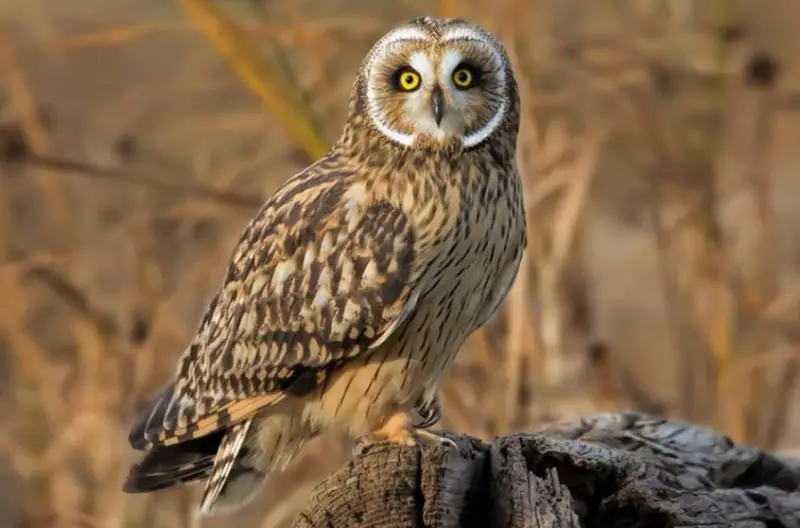
The Short-eared Owl is a medium-sized owl with a length of about 13 to 17 inches and a wingspan of 33 to 41 inches. It has broad, rounded wings, a relatively short tail, and small, often inconspicuous ear tufts. Its plumage is buffy with dark streaks, and its pale face is accented with yellow eyes and black outlines. It is best known for its moth-like flight and erratic movements over open fields.
This species is crepuscular, being most active at dawn and dusk. It is one of the few owls that can frequently be seen flying during daylight, particularly in the late afternoon. It flies low over grasslands and marshes, often flapping and gliding in a buoyant manner while scanning the ground for movement.
Short-eared Owls primarily feed on small mammals, especially voles, lemmings, and mice. They hunt by flying low over open terrain and diving suddenly to capture prey. Their nests are simple scrapes on the ground, lined with grass and feathers. Ground-nesting makes them vulnerable to predators and human disturbance, though their cryptic plumage offers some protection.
In Colorado, Short-eared Owls are typically seen in open habitats such as grasslands, agricultural fields, and marshes, especially during migration and winter. They are more common in the eastern plains and lower valleys but may also be found in wetlands at higher elevations. Their population fluctuates depending on prey availability and habitat conditions.
Northern Pygmy-Owl (Glaucidium gnoma)
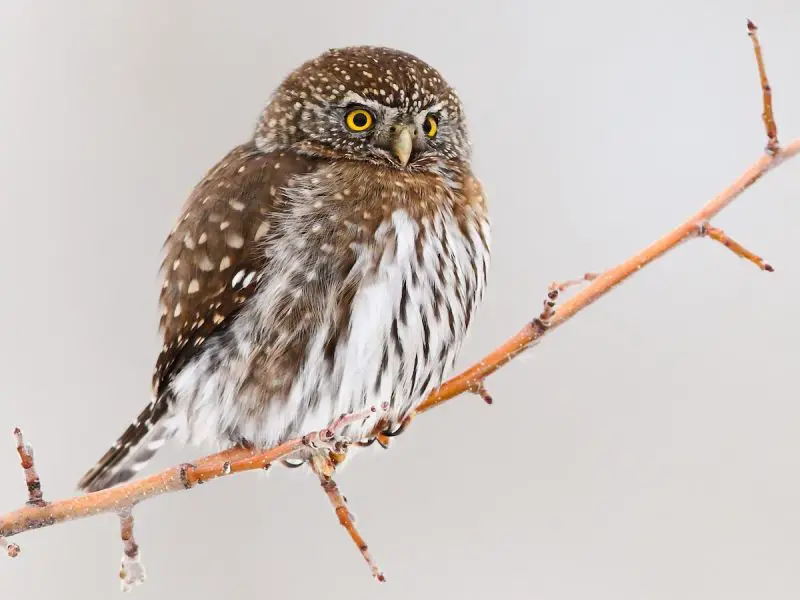
The Northern Pygmy-Owl is a tiny but bold predator, typically measuring only 6 to 7 inches in length with a wingspan of about 14 to 16 inches. Despite its small size, it has a fierce look, thanks to its yellow eyes, gray-brown plumage with white spots, and distinctive “false eyespots” on the back of its head. These markings likely confuse predators or prey by mimicking a forward-facing stare.
Unlike most owls, this species is diurnal, hunting during the day. It is known for its surprising aggression, often taking prey its own size or larger. It hunts from perches in trees and shrubs, darting out swiftly to catch birds, mammals, or insects. Its call is a series of repetitive, high-pitched toots, often heard in forested areas during the breeding season.
Northern Pygmy-Owls primarily feed on small birds, mice, voles, and large insects. They use their keen eyesight and rapid strikes to capture prey, often storing extra food in tree cavities. Their hunting behavior is energetic and direct, making them one of the most efficient small owl species in North America.
In Colorado, Northern Pygmy-Owls are most commonly found in montane forests of the western part of the state. They prefer mixed coniferous woods, including fir, spruce, and pine, especially at elevations between 7,000 and 10,000 feet. Though more often heard than seen, they can be detected during the day by their calls or by observing alarmed songbirds mobbing them in the forest canopy.
Flammulated Owl (Psiloscops flammeolus)
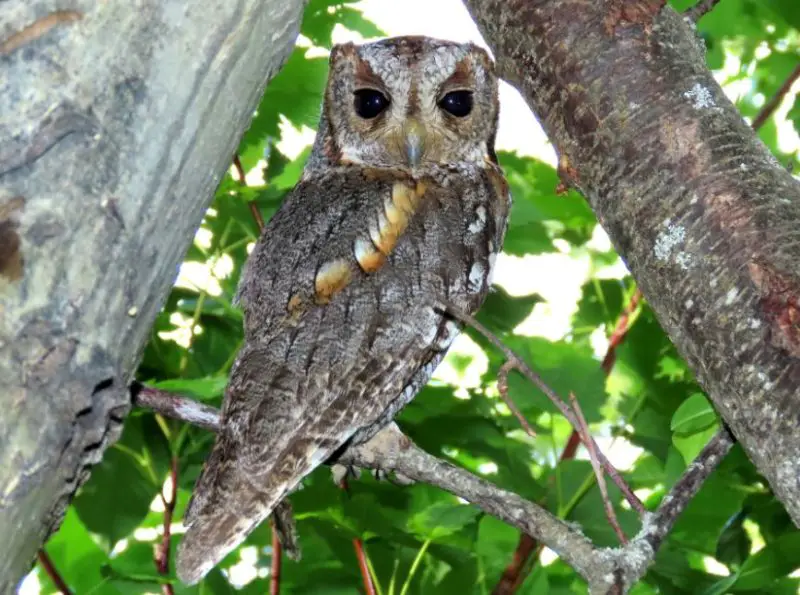
The Flammulated Owl is a small and slender species, about 6 to 7 inches in length with a wingspan around 14 inches. It is distinguished by its dark eyes, tiny ear tufts, and reddish-brown to grayish plumage with flame-like streaks across its body. This camouflage allows it to blend easily into the bark of ponderosa pines, making it exceptionally difficult to spot. Its call is a soft, low-pitched “boop” or hoot, easily mistaken for a distant frog.
This species is primarily nocturnal and migratory, arriving in Colorado during late spring and leaving by early fall. During the breeding season, males sing persistently at night to establish territory. They roost silently during the day in dense foliage, often near the trunks of tall pine trees. Their secretive habits and quiet calls make them one of the least detected owls in their range.
Unlike most owls, the Flammulated Owl feeds almost entirely on insects. Moths, beetles, crickets, and other nocturnal invertebrates make up the bulk of its diet. It hunts on the wing or by gleaning insects from tree trunks and leaves. The owl’s small size and lightweight build allow it to maneuver easily through dense forest in pursuit of prey.
In Colorado, the Flammulated Owl is found mainly in mature ponderosa pine and mixed-conifer forests of the central and southern mountains during the summer breeding season. They nest in old woodpecker cavities and are sensitive to habitat disturbances. Because of their reliance on specific forest types and quiet behavior, they are often underreported in surveys.
Boreal Owl (Aegolius funereus)
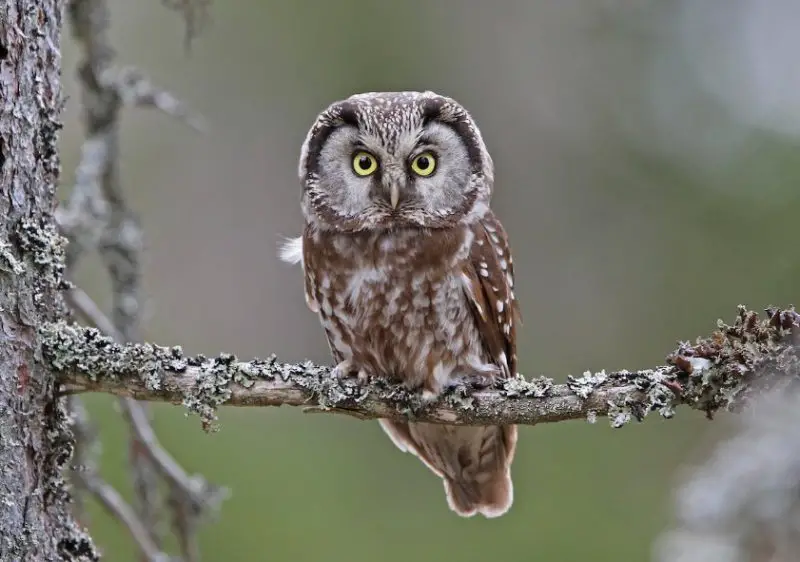
The Boreal Owl is a small, secretive species native to cold, high-altitude forests. Measuring about 8 to 10 inches in length with a wingspan of 20 to 24 inches, it has a large, rounded head with no ear tufts and a whitish facial disk edged in dark brown. Its back is chocolate-brown with white spots, while its underside is paler with streaking. Large yellow eyes give it a penetrating stare, ideal for its nocturnal hunting.
This owl is nocturnal and highly elusive, often remaining still and silent during the day. Its haunting, rhythmic hoots can be heard echoing through the forest at night, especially during the early breeding season. It is a cavity-nester and relies heavily on natural tree cavities or old woodpecker holes in mature forests.
The Boreal Owl primarily preys on small mammals, especially voles and shrews, though it may also consume small birds and insects when available. It hunts by perching and scanning the forest floor before swooping down with precise strikes. Its excellent hearing helps it locate prey under snow or leaf litter in winter.
In Colorado, the Boreal Owl is rare and found only in high-elevation spruce-fir forests of the northern Rocky Mountains, such as in Rocky Mountain National Park. It is considered a year-round resident in these remote areas, though sightings are infrequent. The species is sensitive to changes in forest structure and is monitored as part of high-elevation biodiversity assessments.


